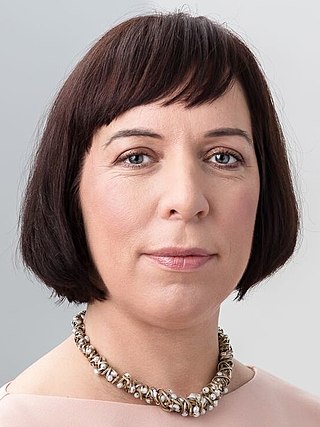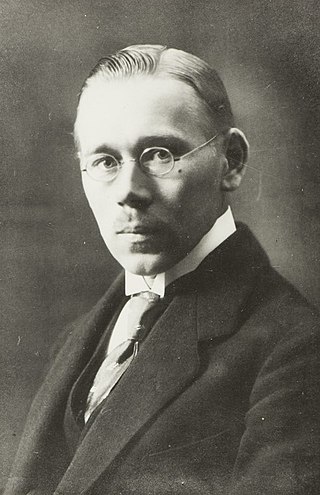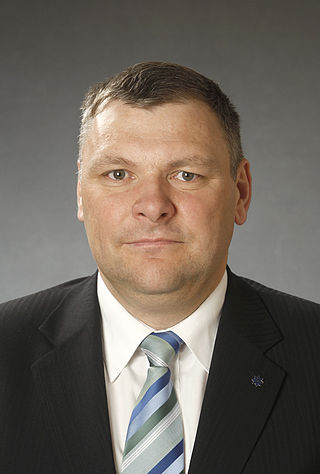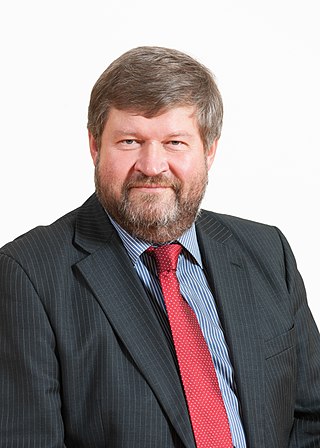
Tartu is the second largest city in Estonia after Tallinn. Tartu has a population of 97,435. It is 186 kilometres southeast of Tallinn and 245 kilometres northeast of Riga, Latvia. Tartu lies on the Emajõgi river, which connects the two largest lakes in Estonia, Lake Võrtsjärv and Lake Peipus. From the 13th century until the end of the 19th century, Tartu was known in most of the world by variants of its historical name Dorpat.

The history of Estonia forms a part of the history of Europe. Humans settled in the region of Estonia near the end of the last glacial era, beginning from around 8500 BC.

Siim Kallas is an Estonian politician, former Prime Minister of Estonia, and former European Commissioner. He served as the European Commissioner for Transport between 2010 and 2014. Before that he was the European Commissioner for Administrative Affairs, Audit and Anti-Fraud between 2004 and 2009. In both Barroso Commissions he was also a Vice-President. He was twice appointed the Acting Commissioner for Economic and Monetary Affairs and the Euro in Olli Rehn's stead, from 19 April 2014 to 25 May 2014 while he was on electoral campaign leave for the 2014 elections to the European Parliament and from 1 July 2014 to 16 July 2014 after he took up his seat.

Konstantin Päts was an Estonian statesman and the country's president in 1938–1940. Päts was one of the most influential politicians of the independent democratic Republic of Estonia, and during the two decades prior to World War II he also served five times as the country's prime minister. After the 16–17 June 1940 Soviet invasion and occupation of Estonia, President Päts remained formally in office for over a month, until he was forced to resign, imprisoned by the new Stalinist regime, and deported to the USSR, where he died in 1956.

The ministries of Poland are the various departments performing functions implemented by the Polish government. Each ministry is headed by a governmental minister selected by the Prime Minister, who sits in the collective executive Council of Ministers. The current competences and regulations of the ministries were established under a series of central administrative reforms carried out by prime ministers Józef Oleksy and Włodzimierz Cimoszewicz between 1996 and 1997. Under legal regulations, the cabinet can create, combine, or dissolve ministries, with the Prime Minister determining the scope and responsibilities of ministers. The number and range of ministries has varied throughout the past.

Tõnis Lukas is an Estonian politician, former Minister of Culture from 2019 to 2021 and Minister of Education and Research from 1999 to 2002 and from 2007 to 2011.

Mailis Reps is an Estonian politician, a member of the Estonian Centre Party. She served as the Minister of Education and Research from 2002 to 2003, 2005 to 2007 and 2016 to 2020.

August Rei VR III/1 was an Estonian politician, the Head of State (Riigivanem) of Estonia in 1928–1929, and the Prime Minister in duties of the President of Estonia in the government in exile in 1945–1963.

Jaak Aaviksoo is an Estonian politician and physicist, a former rector of the University of Tartu and Tallinn University of Technology (TalTech).
An education minister is a position in the governments of some countries responsible for dealing with educational matters. Where known, the government department, ministry, or agency that develops policy and delivers services relating to sports are listed; overseen by and responsible to the education minister. The first such ministry ever is considered to be the Commission of National Education founded in 1773 in the Polish–Lithuanian Commonwealth.

Marko Pomerants is an Estonian politician. He was the Minister of the Environment in 2015–2017. Previously, Pomerants has served as the Minister of Social Affairs from 2003 to 2005 and as the Minister of the Interior from 2009 to 2012. Pomerants is a member of the Pro Patria and Res Publica Union.

Jaak Aab is an Estonian politician of the Centre Party who has served as Minister of Education and Research and three times as the Minister of Public Administration from 2017 to 2018, from 2019 to 2020 and from 2011 to 2022 and as the Minister of Social Affairs (Estonia) from 2005 to 2007.
The history of formal education in Estonia dates back to the 13–14th centuries when the first monastic and cathedral schools were founded. The first primer in the Estonian language was published in 1575. The oldest university is the University of Tartu which was established by the Swedish king Gustav II Adolf in 1632. In 1919, university courses were first taught in the Estonian language.

Estonia–India relations refers to the bilateral diplomatic relations between Estonia and India. India first recognised Estonia on 22 September 1921 when the former had just acquired membership in the League of Nations. India re-recognised Estonia on 9 September 1991 and diplomatic relations were established on 2 December of the same year in Helsinki. Estonia is represented in India by its embassy in New Delhi and its honorary consulate in Mumbai. India is represented in Estonia through its embassy in Helsinki (Finland) and through an honorary consulate in Tallinn.

The Estonian Soviet Socialist Republic, also known as the Estonian SSR, Soviet Estonia, or simply Estonia, was a union republic and an ethnically based administrative subdivision of the former Soviet Union (USSR) covering the occupied and annexed territory of Estonia in 1940–1941 and 1944–1991. The Estonian SSR was nominally established to replace the until then independent Republic of Estonia on 21 July 1940, a month after the 16–17 June 1940 Soviet military invasion and occupation of the country during World War II. After the installation of a Stalinist government which, backed by the occupying Soviet Red Army, declared Estonia a Soviet constituency, the Estonian SSR was subsequently incorporated into the Soviet Union as a "union republic" on 6 August 1940. Estonia was occupied by Nazi Germany in 1941, and administered as a part of Reichskommissariat Ostland until it was reconquered by the USSR in 1944.

Mart Nutt was an Estonian politician and historian, member of the XIV Riigikogu since he was elected in the 2019 Estonian parliamentary election.

Tartu Art Museum is a state-owned museum of art located in Tartu, Estonia. It was founded in 1940 on a private initiative by the members of local art school Pallas. This is the largest art museum in Southern Estonia.

Anu Realo is an Estonian personality and cross-cultural psychologist. She is professor in the Department of Psychology at the University of Warwick, the United Kingdom, and a visiting professor at the University of Tartu, Estonia.

The Ministry of Education and Research is a government ministry of Estonia, responsible for the planning and carrying out education, research, youth, and language policies, developing the national curricula and other educational standards and performing state supervision over the compliance of national curricula and other educational standards and educational institutions. Its head office is in Tartu and it also maintains offices in the capital, Tallinn. The current Minister of Education and Research is Kristina Kallas.
Nikolai Köstner (1889–1959) was an Estonian politician, economist, diplomat and academic. He was a member of the Provisional Assembly of the Autonomous Estonian Governorate (1917–19) and the Constituent Assembly of the newly established Republic of Estonia (1919–20); he also served as a minister in Jaan Raamot's Provincial Government in 1917, in the Second and Third Provisional Governments (1918–19), and in Otto Strandman's first Cabinet and Jaan Tõnisson's first Cabinet. He was also part of the Estonian delegation to the 1919 Paris Peace Conference. In later life, he worked as an academic at the University of Tartu and as an adviser to a number of national banks.
















